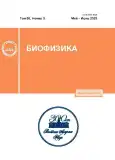Luminescent diagnostics and quantitative assessment of malaria based on a lateral flow immunoassay with cdte quantum dots
- Authors: Chauhan H.1, Jariwala A.1, Kheraj V.1
-
Affiliations:
- Sardar Vallabhbhai National Institute of Technology
- Issue: Vol 68, No 3 (2023)
- Pages: 616-624
- Section: Articles
- URL: https://journals.rcsi.science/0006-3029/article/view/144463
- DOI: https://doi.org/10.31857/S0006302923030237
- EDN: https://elibrary.ru/FTTHTS
- ID: 144463
Cite item
Full Text
Abstract
Keywords
About the authors
H. Chauhan
Sardar Vallabhbhai National Institute of TechnologyGujarat, India
A. Jariwala
Sardar Vallabhbhai National Institute of TechnologyGujarat, India
V. Kheraj
Sardar Vallabhbhai National Institute of Technology
Email: vk@phy.svnit.ac.in
Gujarat, India
References
- X. Shi and Z. Wang, Rev. Med. Microbiol., 32 (3), 183 (2021).
- P. Liu, Y. Zhou, M. Guo, et al., Nanoscale, 10, 848 (2018).
- N. H. T. Tran, K. T. L. Trinh, J. H. Lee, et al., Small, 14, 1801385 (2018).
- R. Fan, W. Zhang, Y. Jin, et al., Microchim. Acta, 187, 1 (2020).
- Y. Liang, X. Huang, R. Yu, et al., Anal. Chim. Acta, 936, 195 (2016).
- G. Liu, J. Zhao, S. Wang, et al., Sensors and Actuators B: Chemical, 306, 127583 (2020).
- S. Wang, C. Zhang, and Y. Zhang, Biosensors and Biodetection, Ed. by A. Rasooly and K. E. Herold (Humana Press, 2009), vol. 504.
- Y. Jeong, Y. M. Kook, K. Lee, and W. G. Koh, Biosens. Bioelectron., 111, 102 (2018).
- S. M. Fothergill, C. Joyce, and F. Xie, Nanoscale, 10, 20914 (2018).
- G. A. Posthuma-Trumpie, J. Korf, and A. Van Amerongen, Anal. Bioanal. Chem., 393, 569 (2009).
- X. Gao, L. P. Xu, S. F. Zhou, et al., Am. J. Biomed. Sci., 6, 41 (2014).
- I. Y. Goryacheva, P. Lenain, and S. De Saeger, Trends Analyt. Chem., 46, 30 (2013).
- O. A. Aladesuyi and O. S. Oluwafemi, Nano-Structures & Nano-Objects, 24, 100568 (2020).
- Z. Li, P. Huang, J. Lin, et al., J. Nanosci. Nanotechnol., 10, 4859 (2010).
- Z. Wang, J.Ruan, and D. Cui, Nanoscale Res. Lett., 4, 593 (2009).
- D. Cui, B. Pan, H. Zhang, et al., Anal. Chem., 80, 7996 (2008).
- M. Sajid, A. N. Kawde and M. Daud, J. Saudi Chem. Soc., 19, 689 (2015).
- H. Yang, D. Li, R. He, et al., Nanoscale Res. Lett., 5, 875 (2010)
- J. Zhang, Y. Wei, S. Qiu, and Y. Xiong, Spectrochim. Acta, Part A: Mol. Biomol. Spectrosc., 247, 119107 (2021).
- U. Resch, H. Weller, and A. Henglein, Langmuir, 5, 1015 (1989).
- T. Lu, K. D. Zhu, C. Huang, et al., Analyst, 145, 76 (2020).
- World malaria report 2020: 20 years of global progress and challenges (World Health Organization, Geneva, 2020). Licence: CC BY-NC-SA 3.0 IGO, https://www.who.int/publications/i/item/9789240015791.
- D. Bell, C. Wongsrichanalai, and J. W. Barnwell, Nat. Rev. Microbiol., 4, 682 (2006)
- A. L. Rogach, L. Katsikas, A. Kornowski, et al., Ber Bunsen Phys Chem., 101, 1668-70 (1997).
- N. Liu and P. Yang, Luminescence, 29 (6), 566 (2014).
- S. Subramanian, S. Ganapathy, M. Rajaram, and A. Ayyaswamy, Materials Chemistry and Physics, 249, 123127 (2020).
- R. Carcione, F. Limosani, and F. Antolini, Crystals, 11 (3), 253 (2021).
- W. W. Yu, L. Qu, W. Guo, and X. Peng, Chem. Mater., 15, 2854 (2003).
- T. Kondratenko, O. Ovchinnikov, I. Grevtseva, et al., Materials, 13, 909 (2020).
- J. Tashkhourian, G. Absalan, M. Jafari, and S. Zare, Spectrochim. Acta A: Mol. Biomol. Spectrosc., 152, 119 (2016).
Supplementary files










